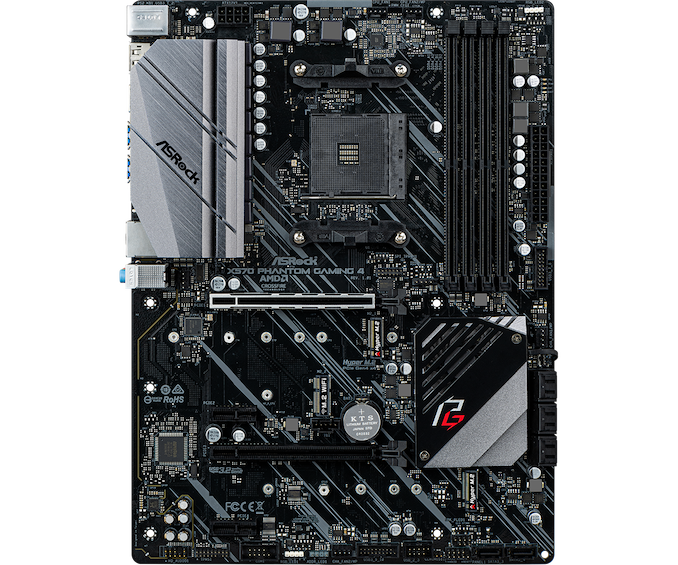The AMD X570 Motherboard Overview: Over 35+ Motherboards Analyzed
by Gavin Bonshor on July 9, 2019 8:00 AM ESTASRock X570 Phantom Gaming 4
The ASRock X570 Phantom Gaming 4 is the more value orientated model of the three Phantom Gaming branded X570 models at launch. Retaining a lot of similar features from the other models, the X570 Phantom Gaming 4 focuses more on offering value for money with a mix of good quality components, simple yet effective aesthetics, and represents its mid-range gaming inspired option. The overall design consists of a black and grey themed PCB, with a black and grey actively cooled chipset heatsink, and a grey power delivery heatsink which is designed to keep the CPU VCore area cool.
On the bottom half of the board is two full-length PCIe 4.0 slots which operate at x16, and x16/x4. This is due to the Ryzen 3000 series processors driving the top lane at x16, while the bottom full-length PCIe slot is driven by the X570 chipset. There are also two PCIe 4.0 x1 slots, as well as two M.2 slots with the top slot supporting PCIe 4.0 x4, and the bottom M.2 slot allowing for both PCIe 4.0 and SATA SSDs. Also featured are eight SATA ports which support RAID 0, 1, and 10 arrays. ASRock's U.2 adapter kit which is available separately is also supported on the X570 Phantom Gaming 4. The ASRock X570 Phantom Gaming 4 also uses a 10-phase power delivery with a single 8-pin 12 V ATX CPU power input, and also includes support for DDR4-4066 memory with four slots available and allowing for a maximum of 64 GB.
The rear panel includes a mid-range offering of connections including two USB 3.1 G2 Type-A, six USB 3.1 G1 Type-A ports, as well as a pair of video outputs consisting of a DisplayPort 1.2, and an HDMI output. There is no USB Type-C featured on this model, but there are an Intel I211-AT Gigabit Ethernet port and three 3.5 mm color coded audio jacks powered by a Realtek ALC1200 HD audio codec. Finishing off the rear panel is a PS/2 combo port, and three antenna ports on the IO shield itself due to the inclusion of an M.2 Key E 2230 slot for users to install their own wireless interface.
Overall the ASRock X570 Phantom Gaming 4 represents a more modest option with a Gigabit Ethernet port, a slightly cut down Realtek ALC1200 HD codec (compared to the ALC1220), and two full-length PCIe 4.0 slots. This model caters to the entry-level gamer with a price that is currently set at $155.












225 Comments
View All Comments
isthisavailable - Wednesday, July 10, 2019 - link
The industry needs to make up its mind when it comes to USB C. Laptops are launching with only USB C and meanwhile $700 motherboards only have 1 USB C port and 8+ "outdated" USB A'sThe_Assimilator - Wednesday, July 10, 2019 - link
It's almost like there's a huge amount of peripherals with USB-A connectors that people who use PCs expect to continue to work when they upgrade! Isn't backwards compatibility a funny feature?Meanwhile, the only peripherals that laptops generally use are docks, hubs, and storage devices - all of which have USB-C versions out the wazoo.
naris - Wednesday, July 10, 2019 - link
Why are memory speeds and channels show & discussed when talking about chipsets when the memory controllers are in the CPUs? Memory controllers have not been in chipsets for many years now!halfflat - Wednesday, July 10, 2019 - link
ECC support can be hard to verify for mere mortals; collating (or even better, verifiying) ECC capability on these motherboards would be an extremely useful addition to the article.ishkatar - Wednesday, July 10, 2019 - link
Does any of the boards support Raid 5? I only see 0, 1 and 10.Zibi - Wednesday, July 10, 2019 - link
You don't want to use RAID 5 without proper RAID Controller with cache.That means dedicated card.
Actually from performance / security perspective RAID 10 is pretty OK.
The_Assimilator - Wednesday, July 10, 2019 - link
AMD dropped RAID-5 support upon introduction of the AM4 socket (remember, chipset functionality like RAID is now a CPU function). I don't have an issue with that, since -5 is a very uncommon use-case in consumer workloads and if you want to do -5 right, you really want a hardware RAID card with a BBU.But -5 is pretty much dead anyway due to ever-increasing drive sizes - the rebuild time on anything over 1TB is horrendous, what you really want in such a scenario is RAID-6, and no consumer motherboard every has or will support that.
And please don't tell me you're using RAID-5 for data integrity, because invisible corruption is a thing that I have experienced personally. If you want *actual* data integrity, use Windows Storage Spaces or RAID-10, and as a last resort RAID-6.
Arbie - Wednesday, July 10, 2019 - link
There must be something you left out of this roundup. Whatever it was, please go back and put it in, and next time get it right. Thanks.Korguz - Wednesday, July 10, 2019 - link
huh ????Gastec - Wednesday, July 10, 2019 - link
That $700 must be an error right, perhaps of judgement?